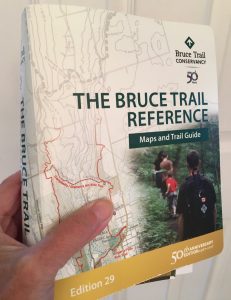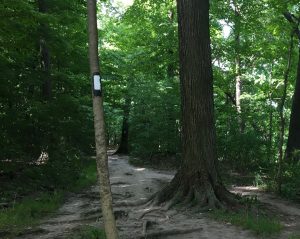 While the pandemic has been busy disrupting our lives, many of us headed outdoors to bike, walk, hike and take in the peace of being in nature.
While the pandemic has been busy disrupting our lives, many of us headed outdoors to bike, walk, hike and take in the peace of being in nature.
My 2020 was already going to include hiking along the Bruce Trail, Canada’s oldest and longest marked hiking trail (898 kilometres or about 558 miles). At Christmas, I had given my husband the fat, spiral-bound Bruce Trail Reference Maps and Trail Guide shown here. We finally used it this summer.
While hiking through a section of the Bruce Trail, it struck me – word nerd alert! – that much advice for hikers can be applied to writers:
1. Plan ahead
“Planning is an important part of every hike,” the guide says. It encourages hikers to look at a map, choose a trail and decide where you’ll park. These days, that’s especially important, since COVID-19 precautions limit the number of hikers on the trail and you must reserve a space. You’re also advised to check the weather forecast, bring water and snacks, and wear a hat, sunglasses and appropriate footwear. We saw a number of people who did not get that last message and were trying to clamber over uneven rocks wearing flipflops. Yikes.
Writers: Your writing is all the better if you think about what your readers need and want to know. You don’t necessarily have to create an outline, but it helps to think through and at least mentally map out where your writing is going. What are the main points you want to make? Do you need to suggest places to find more detailed information? Do you need a “call to action” and is it clear?
2. Signal the required effort
The Bruce Trail guidebook and posted signs show the walking trails and note how long or difficult the hike is and how experienced the hiker must be. The guide notes where trails are extremely rugged, even treacherous, with steep hills, tight turns and uneven surfaces, and if there are few places to rest.
Writers: Show that a piece won’t take much effort to read by using white space and frequent breaks (in sentences and paragraphs) where readers can catch their breath. Avoid a wall of text by using headings, subheadings, bulleted lists, pictures or graphics and other different design treatments to give eyes a rest and signal, “Hey, this won’t be difficult.”

3. Show the way
On the Bruce Trail, painted rectangles called “blazes” (shown on the skinny tree in the foreground) guide hikers, showing where to go left, right or straight ahead. When walking, you’ll usually see at least one blaze ahead, giving you confidence that you’re on the right path. If you don’t see one ahead, you’re going off the trail and you should backtrack to the last blaze.
Writers: As with signalling the amount of effort, you can guide readers through your writing with headings, subheadings and the use of white space. Smooth the path to understanding with short, familiar words in short, scannable, easy-to-read sentences. Show that readers are on the right path by using transitional expressions (such as similarly, for example, however, in particular) that make logical connections between sentences, paragraphs and sections of your work.
4. Set the pace
For the most part, hiking along the Bruce Trail is, as the guidebook says “neither dangerous nor difficult.” Most of the trail can be enjoyed by “any moderately active, healthy person,” but take your time. It’s not a race. Set a pace that you can keep up for the length of the trail you’ve chosen.
Writers: Set a pace that readers can follow. Use the already mentioned short, easy-to-read sentences. Throw commas into longer sentences to offer places to pause. Match the effort of hiking with what The Canadian Writer’s Handbook calls “the direct and more vigorous active voice.”
5. Build in breathers
The Bruce Trail features deep woods, towering ancient trees and spots that overlook spectacular waterfalls and deep gorges carved over centuries. Build in time to rest and take in the scenery. Practice “forest bathing,” where you take in the sights and smells and sounds of the forest. Listen for the call of birds, the flutter of leaves, the hush of wind. Pause often and look up and around, since as you hike you’ll have to look down to navigate roots, rocks and branches. It helps if you’ve given yourself enough time to cover the trail and aren’t rushing to get back to a parking lot before dark.
Writers: Build in places for readers to stop and rest, especially in a long piece. Make paragraphs short (although usually more than one sentence, please). Help readers visualize your topic through examples and vivid analogies. Use photos, illustrations, charts and graphics to complement, explain or expand on your text.
How about you – what have you newly discovered thanks to the pandemic? Are you a hiker? If you’ve hiked the Bruce Trail, which section did you most enjoy? Please share in the comments.
This post first appeared in the September issue of my newsletter. Wordnerdery is a quick read about words, effective/expressive writing, newsletters and more. Are you a subscriber yet? If yes, thanks for reading! If not, you can sign up right now. In keeping with Canada’s anti-spam laws and just plain good manners, you can easily unsubscribe any time.
